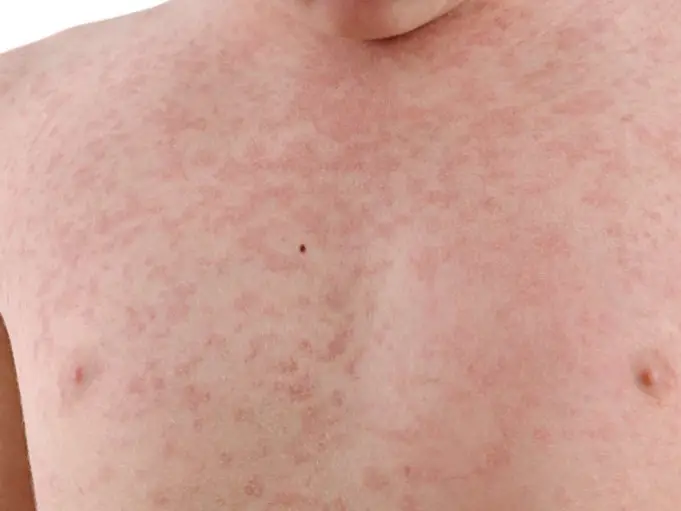Rubella is also known as German measles. It is an infection that is caused by a virus, and it causes rashes that are reddish in colouration. On most occasions, asides the rash, patients who have German measles have the presence of fever and swollen lymph nodes.
It is a very infectious disease that spreads from one person to another via contact with the droplets and waste products from an infected person to another most especially when it comes from the touch of the person’s fluid such as sweat, saliva or sputum.
This only means that you can get this disease if you come in contact with your mouth, nose, or eyes after touching the infected person or touching a substance that has droplets from an infected person.
Another method by which you can contract German measles is by sharing both foods or drink from the person. Also, when you share cutleries and clothing with an infected person, you may likely be infected too.
German measles is caused by a virus known as rubella. It is a very highly contagious disease that is spread through direct or indirect contact with the person as well as it can be gotten as well from the air.
When an infected person sneezes and coughs, you can inhale the virus through the air into your airways. A pregnant woman can also pass along the virus to her unborn baby via the bloodstream.
People who have rubella are contagious most especially in their first 2 weeks when the rash appears. After about two weeks, the rash will disappear, and hence the person is no longer contagious anymore.
Symptoms
The symptoms of rubella are Usually very mild, often so slight that it is possible to miss the signs. The symptoms usually take about 2 weeks before the initial exposure before the patient begins to experience it and they only last for about 7-8 days before they are gone. The symptoms of German measles include:
- A pink or reddish rash that usually starts from the face and hence spreads downwards throughout the other parts of the body.
- A fever indicated with a mild temperature of about 101-102°C
- Swollen lymph nodes which are tender to touch.
- A runny nose or the patient might be experiencing a blocked nose or a stuffed nose.
- Headaches
- Severe muscular pains.
- Red eyes which appear swollen or inflamed.
- Severe joint aches which are commonly seen in young women.
These symptoms may not look like much initially as they don’t seem harmful. However, ensure you report to your doctor if you suspect German measles. In some sporadic cases, if left untreated for a while, German measles will lead to brain swelling and ear blockage.
If the symptoms are becoming very severe and you begin to experience signs such as a stiff neck, a dull constant headache as well as earaches, please ensure you visit your doctor.
Complications
Rubella is the kind of infection that usually appears mild, and once you have been treated for the virus, it is impossible to get the disease again. This means that the person grows immune to the rubella virus.
However, the highest complication of the rubella virus occurs if the patient who may be a lady is pregnant. Rubella is quite a dangerous, dangerous disease for a pregnant woman as well as the developing baby in her uterus. It is so hazardous that the U.S health ministry warns that women must ensure that the lady is vaccinated before she even dares to get pregnant.
The infection of rubella virus causes severe problems and damage when the woman is infected with the virus most especially during the earlier weeks of pregnancy. If this infection occurs in her first 12 weeks of pregnancy, then it will be deadly for both mother and child.
The infection in a pregnant woman brings about a syndrome called the Congenital Rubella Syndrome. The congenital Rubella Syndrome also is known as CRS is a condition or sequence of events that happens in a baby in the womb when his/her mother is infected with the disease. The major problem or risk of contracting rubella while you are pregnant is either the lady has a miscarriage, or the baby dies in the uterus resulting in the birth of a stillborn.
In some cases, the woman may not miscarry, or the baby might not die, however, the baby will experience various severe congenital disabilities and consequences which can be lifelong and be very devastating.
CRS once it starts to occur in the baby, it begins to attack all the body systems of the baby. This is because the developing embryo hasn’t even developed an immune system yet. The most common congenital disabilities caused by CRS include:
- Deafness
- Cataracts
- Congenital heart defects
- Intellectual disabilities and mental problems
- Severe Liver and spleen damage
- Low birth weight
- Severe skin rash.
However, asides these complications, there are some less common complications such as
- Glaucoma
- Brain damage
- Hormonal problems and thyroid damage.
- Inflammations of the Lungs can occur as well as swellings the surrounding blood vessels.
Treatment
Most cases of German measles are treated at home. Doctors may ask you to relax in bed and take acetaminophen otherwise known as Tylenol. This is to help you relieve the stress and pains you were maybe feeling at that time. They will ask you to stay home away from work or school so as not to infect anyone or spread the disease around.
However, for pregnant women, they will be given a dose of antibodies such as hyperimmune globulin. This will help fight off the virus and help protect the baby and reduce most of the symptoms.
However, this may not be enough as the baby might still develop the Congenital Rubella Syndrome. A baby who has developed this disease will need to undergo surgery and be operated on by a group of specialised doctors
Prevention
Most vaccinations are taken for most people, and it has been proven as a safe way to prevent this disease. The vaccine is usually given alongside those of measles, mumps, and chicken pox.
These vaccines must be given to babies who are between the ages of 12-15 months old with another shot which is to be provided when the child is 4-6 years old. This shot is to act as a booster shot to the immune system.













